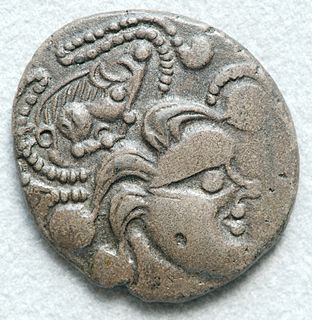Related Research Articles

The Taurini were a Celto-Ligurian tribe dwelling in the upper valley of the river Po, around present-day Turin, during the Iron Age and the Roman period.
The Viducassēs were a Gallic tribe dwelling in the modern Calvados department during the Iron Age and the Roman period.

The Bodiocasses or Baiocasses were an ancient Gallic tribe of the Roman period. They were a tribal division of the civitas of the Lexovii, in the Roman province of Gallia Lugdunensis.
The Alauni were a Gallic tribe dwelling around the lake Chiemsee during the Roman period.

The Eburovīcēs or Aulercī Eburovīcēs were a Gallic tribe dwelling in the modern Eure department during the Iron Age and the Roman period. They were part of the Aulerci.
The Latobici or Latovici were a Slavic tribe dwelling in Pannonia Superior, around present-day Drnovo (Slovenia), during the Roman period.
The Veliocasses or Velocasses were a Belgic or Gallic tribe of the La Tène and Roman periods, dwelling in the south of modern Seine-Maritime and in the north of Eure.

The Vindelici were a Gallic people dwelling around present-day Augsburg (Bavaria) during the Iron Age and the Roman period.
The Vediantii were a Celto-Ligurian tribe dwelling on the Mediterranean coast, near present-day Nice, during the Iron Age and the Roman period.
The Aneuniates were a small Gallic tribe dwelling near Lake Como, around present-day Samolaco, during the Roman period.
The Nemeturii or Nemeturi were a Gallic tribe dwelling in the Alpes Maritimae during the Iron Age.
The Venisami or Venisamores were a Gallic tribe dwelling in the Alps during the Iron Age.
The Ambisontes were a Gallic tribe dwelling in the upper Salzach valley during the Roman period.
The Vennones or Vennonetes were a Gallic or Rhaetian tribe dwelling in the northern Alps, between Chur and Lake Constance, during the Iron Age and the Roman era.
The Rucinates or Rucantii were a Gallic tribe dwelling in near the confluence of the Isar and Danube rivers during the Roman period.
The Catenates or Cattenates were a Gallic tribe dwelling between the Isar and Inn rivers during the Iron Age.
The Licates were a Gallic tribe dwelling in the upper valley of the Lech river during the Iron Age and the Roman period.
The Ambidravi were a Gallic tribe dwelling around the upper Drava river, near Teurnia (Switzerland), during the Roman period.
The Ligauni were a Celto-Ligurian tribe dwelling near the Mediterranean coast during the Iron Age and the Roman period.
The Brixentes or Brixenetes were a Celtic tribe living in the Alps during the Iron Age and the Roman era.
References
- ↑ Ptolemy. Geōgraphikḕ Hyphḗgēsis, 2:13:2.
- ↑ Falileyev 2010, s.v. Ambilikoi.
- 1 2 Delamarre 2003, p. 201.
- ↑ de Bernardo Stempel 2015, p. 89.
- ↑ de Bernardo Stempel 2008, p. 107.
- ↑ Talbert 2000, Map 19: Raetia.
Bibliography
- de Bernardo Stempel, Patrizia (2008). "Linguistically Celtic ethnonyms: towards a classification". In García Alonso, Juan Luis (ed.). Celtic and Other Languages in Ancient Europe. Ediciones Universidad de Salamanca. ISBN 978-8478003358.
- de Bernardo Stempel, Patrizia (2015). "Zu den keltisch benannten Stämmen im Umfeld des oberen Donauraums". In Lohner-Urban, Ute; Scherrer, Peter (eds.). Der obere Donauraum 50 v. bis 50 n. Chr. Frank & Timme. ISBN 978-3-7329-0143-2.
- Delamarre, Xavier (2003). Dictionnaire de la langue gauloise: Une approche linguistique du vieux-celtique continental. Errance. ISBN 9782877723695.
- Falileyev, Alexander (2010). Dictionary of Continental Celtic Place-names: A Celtic Companion to the Barrington Atlas of the Greek and Roman World. CMCS. ISBN 978-0955718236.
- Talbert, Richard J. A. (2000). Barrington Atlas of the Greek and Roman World. Princeton University Press. ISBN 978-0691031699.
